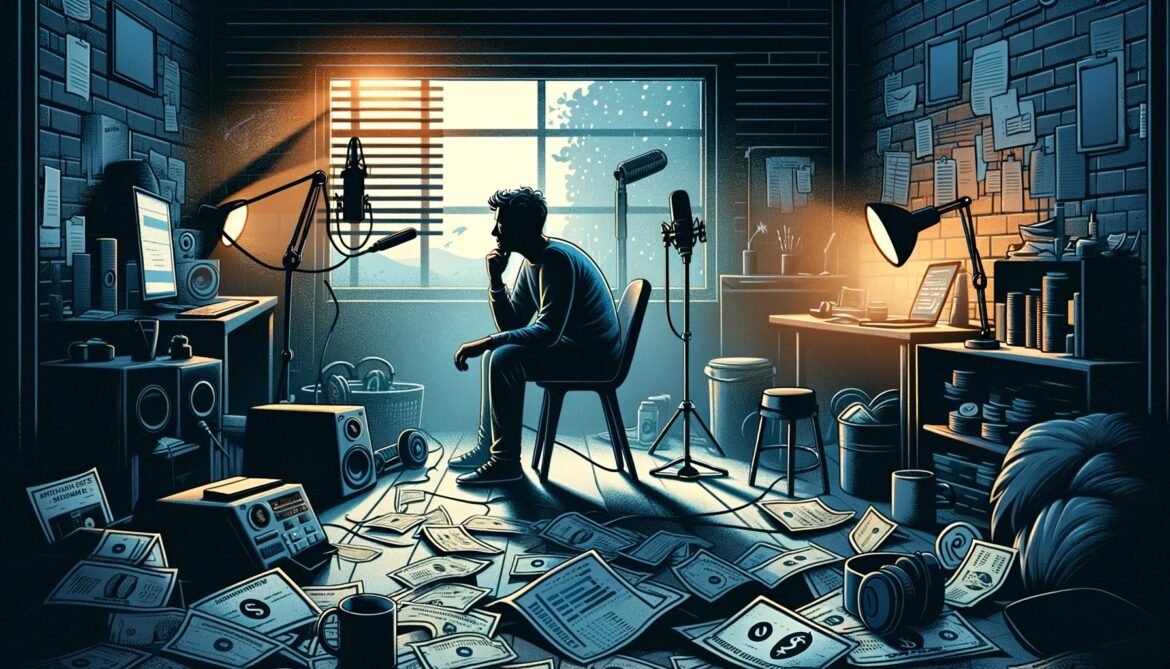Why our system for valuing podcasts is broken

Mike Janssen, using DALL-E 3
The CPM model of advertising does not — and will not ever — work to sustain podcasting.
Back when I was working as Head of Content for Pushkin Industries, I never made it my business to truly understand how the CPM model works. I had my hands full with all the shows and people I was managing, and we had talented folks handling the marketing and sales. So I left that work to them.
I heard complaints about it, for sure: too many shows to sell at once, not enough revenue, bad partnerships, endless misunderstandings and frustrations. Back then I stayed out of the weeds. But now that I’m focused on a new vision for funding audio storytelling, I need to wrap my head around what, exactly, is wrong with the current model.
So I did a bit of research.
Let’s begin with the basics: What even is a CPM? I found this straightforward definition in the Online Advertising Guide.
The M stands for “Mille,” or the Roman numeral for 1,000. And impressions essentially equals download numbers since most people only listen to a podcast once.
CPMs were first introduced in 1995 to set advertising rates for online banner ads. On a static website, it was a convenient and fair way to determine the value of an advertising campaign. And that became the norm for all digital advertising content.
In a podcast episode, there are basically three opportunities to advertise:
- Before the show (pre-roll)
- In the middle of the show (mid-roll)
- After the show (post-roll)
But these three methods are not created equal. Pre-roll and mid-roll spots are viewed as the most valuable, because who really listens all the way through the show credits, much less to the ads that follow? Also, there’s a limit to how many ads you can run while still maintaining the integrity of the listening experience. Too many ads ruin the mood. The rule of thumb in my experience is one pre-roll, two mid-rolls, and one post-roll.
In the early podcasting days, advertisers quickly learned that host-read ads are the most effective. This is when the trusted narrator of the podcast shares their firsthand experience with the product or service they’re advertising, trying to sound as genuine as possible. Serial’s Mailchimp ad is the classic example of this.
There are all kinds of ethical concerns here. The whole idea of “ad music” came about when listeners got confused about the difference between show content and ad content. (Gimlet, at the time, wrote up this handy guide.)
Plus these ads — especially the engaging ones — can take a lot of time to write, record, and produce, taking valuable time away from show production and adding to overall production costs.
How are CPMs valued?
According to Acast — one of the biggest podcast ad sales companies around — average CPM rates for podcasts range from $15 for a pre-recorded 60-second spot to $40 for a host-read ad.
Since CPM rates are based on impressions/download numbers, and new shows don’t know how many downloads they’ll get, CPM rates are generally based on estimates for how a show will perform. If a show does well, everybody wins. But if a show underperforms, the company who sold the ad has to offer what’s called a make good — offering spots on other related shows to fill the void. Not a good situation for anyone.
Let’s be generous and say a show runs four host-read ads at the $40 rate.
That’s $160 for every 1,000 impressions.
In a previous essay I talked about fair rates for creators at various experience levels. Survey respondents determined that $60,000 is a fair yearly baseline salary for an entry-level producer. That means a show would need to have 375,000 downloads in a year to pay for that one producer’s salary with CPM-based ad revenue.
I also argued that the yearly cost of a highly-produced, 10-part narrative show made by a top-notch team amounts to about $500,000.
A show like that would need over 3 million downloads in a year just to break even.
Of course, there are shows that get more downloads than that, typically “always on” shows. But according to the 2023 Podcast Marketing Trends Report, the majority of podcasts, even high-quality ones, get far less.
There are other factors at play
Some podcasts can secure higher CPM numbers by having longer host-read ads or high-profile talent. But those high-profile talents typically have some kind of revenue-share deal, so any extra dollars earned are likely not contributing to the bottom line, much less trickling down to the production team.
Some advertisers are interested in reaching niche audiences with particular subject matter and will pay a premium for that access. And some event-related pods or other timely shows will garner higher rates. Plus you can bundle a bunch of shows together and sell ads across a whole network or series of shows rather than sell them individually. That’s how most of the existing networks do it, and it’s the best way to guarantee the scale and reach most advertisers are looking for.
But that means each show/creator gets an even smaller slice of the pie. Plus podcast ads are easy to skip. Advertisers shy away from any podcast content that’s controversial or overly sensitive. And many shows don’t book any ads at all.
Here’s another complicating factor: When Apple released its iOS 17 operating system at the end of 2023, download numbers dropped across the board. This was a carefully thought-out change on Apple’s part to ensure more accurate download reporting. But there are other instances when creators of shows big and small see unexplainable changes to their download numbers. Outages, hacks, bots — no doubt there are countless ways to game the system. Guidelines put in place by the Interactive Advertising Bureau try to create some order in the download chaos.
But the bottom line is this: Any system that relies on download numbers to determine the value of a podcast is unreliable, unfair, and untenable.
The CPM model does not work for podcasts.
What about sponsorships?
There’s another way to secure advertising dollars for podcasts — sponsorships. That’s when an advertiser supports a whole show or series of shows, associating their name or brand with the content in a broader sense. This is typically done through a promotional spot at the beginning or end of a show. And it’s most commonly heard on public radio in the form of underwriting.
Public radio stations actually aren’t allowed to use host-read ads. It’s seen as a conflict of interest and unethical for reporters to speak on behalf of the products or services that are funding their show. So instead, the ads (or underwriting spots) are read by a neutral voice with a clear separation between the two.
Unlike CPMs, underwriting rates are flexible, and are based on the perceived value of the listening audience. So how do you figure that out?
Public radio primarily uses Nielsen ratings to determine who is listening to what and for how long. The history of Nielsen is long and fascinating, and you can read about it here. But most important, for our purposes, is that their metrics are based on actual human behavior. Nielsen installs hardware in people’s homes to track their viewing and listening. They ask people to record daily diaries chronicling their media habits. And since 1987, they’ve had “People Meters” (now wearable) to track listener behavior as accurately as possible.
Until recently, Nielsen wasn’t able to track headphone listening. But they are constantly evolving, and actual human behavior remains at the center of the equation.
Salespeople take these Nielsen ratings along with a bunch of other metrics and go out into the marketplace to convince advertisers that their station’s shows will reach listeners who will buy their brands. And they convince those brands to pay a premium to reach those audiences.
The rates are nuanced and specific, and, I would argue, a much better way to do pricing.
But from what I can tell, even the most well-funded radio stations have not been able to bundle their broadcast offerings with their podcast offerings when selling underwriting, leaving their podcasts reliant on that broken CPM model. And even with underwriting options, public radio stations are not immune to the chaos and mass layoffs of the past year.
So what now?
Whether you’re listening in a podcast app or on a terrestrial broadcast, high-quality content is essentially the same: a combination of reported narratives, interviews, and chat shows. Nearly all stations offer up their broadcast content through online streaming services or other apps, and more and more podcasts are making broadcast deals to distribute their content via terrestrial radio.
If we listen to the content in the same way, shouldn’t we pay for it in the same way, too?
Shouldn’t there be a way to combine the human-centered, nuanced approach of radio underwriting with the high-volume, purely quantitative model of CPMs?
Building off my idea of a cooperatively-run network, where creators can make a sustainable living and shows are monetized through a grassroots salesforce:
- What if the network included “podcast stations” that operate like radio stations, but with more content and less overhead?
- What if we moved away from a CPM model and instead used human-generated metrics to determine the value of a podcast listening audience?
- What if the salespeople are true fans of the content they’re selling, and maybe even read the ad spots themselves?
- And what if salespeople sold not just ads and underwriting spots, but memberships, too? Sales is sales, right? There’s something for everyone.
I’ve been kicking around these ideas with Kristen Hayford, a veteran marketing professional who’s been testing some of these theories with The Kids Should See This. The membership-supported website offers curated educational content for kids, helping parents “avoid ‘the Wild West’ of YouTube algorithms.” I’ll be watching her work closely.
For now, I’ll leave you with this good news:
- According to the IAB’s 2023 US Podcast Advertising Revenue Study, podcast ad spending reached $1.8 billion dollars last year and is expected to grow to roughly $4 billion by 2025.
- Ad revenue for terrestrial radio is around $13 billion.
- And just for context, YouTube ad revenue topped $30 billion last year.
There are a lot of ad dollars to go around. Let’s figure out how to distribute them differently.
Mia Lobel is a veteran audio producer, manager and educator, and the founder of the long-standing community group, Freelance Cafe, a networking resource for public media independents, now in the form of a Substack. Building on her experience as the former Head of Content for Pushkin Industries, she now works as a mentor and consultant, helping individuals and companies build great teams, set up sustainable production processes and create impactful, entertaining and memorable content.







This just validates one of the key points Donna Papacosta and I made in our book, “The Business of Podcasting: How to Take Your Podcasting Passion from the Personal to the Professional,” (www.thebusinessofpodcasting.com) nearly eight years ago. Advertising and subscriptions for most podcasters will not work. What works is getting a presenting sponsor to cover production costs for the halo effect of saying they presented the podcast.